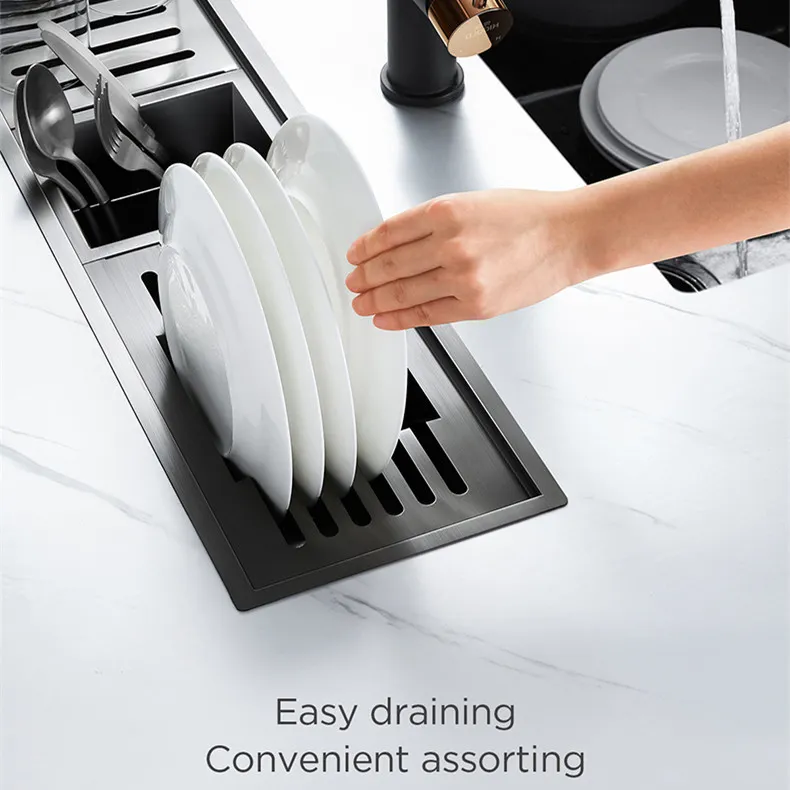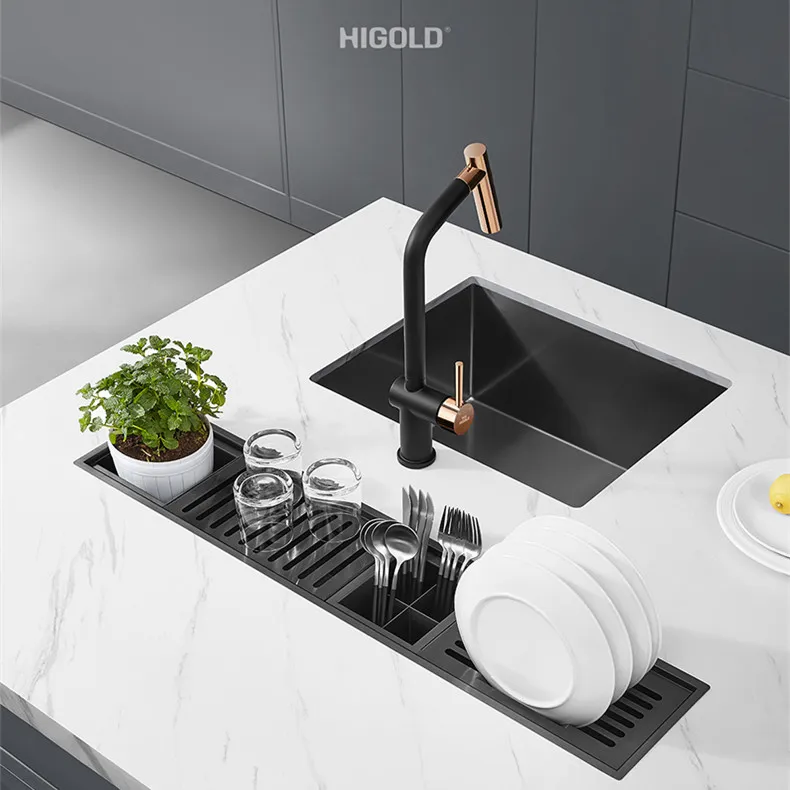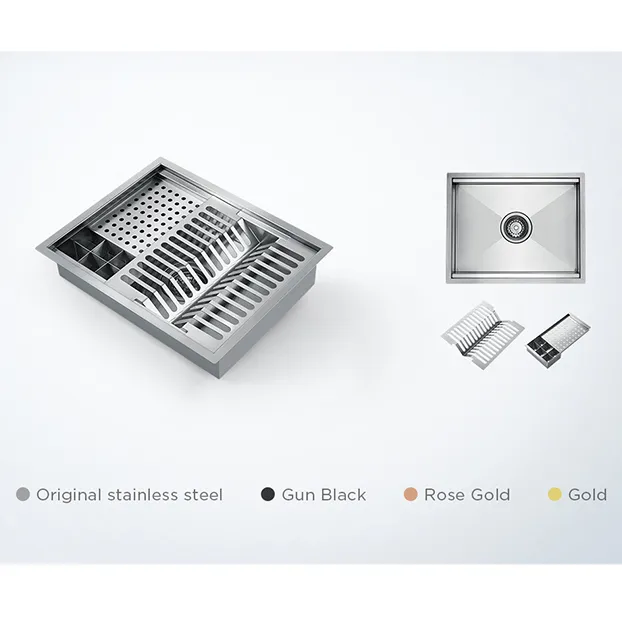Traditionally, stainless steel sinks are often seen as silvery white or metallic, a color derived from the inherent properties of the material. However, in recent years, more and more black stainless steel sinks have appeared on the market. Their calm, elegant, and modern appearance has quickly captured the attention and curiosity of consumers. Many people ask: Why are some stainless steel sinks black?
This article will address this question, combining various aspects, including stainless steel material properties, surface treatment processes, functional performance, aesthetic effects, and daily maintenance, to provide a comprehensive explanation of the reasons for the emergence of black stainless steel sinks and the technical logic behind them.

Stainless Steel Sink Materials: Do You Know?
To understand the origins of black stainless steel sinks, it's important to first understand their basic materials.
1. Common Types of Stainless Steel
Stainless steel sinks are mostly made of either 304 or 316 stainless steel. 304 stainless steel is the most common kitchen material due to its excellent corrosion resistance and mechanical strength. 316 stainless steel, based on 304 stainless steel, has molybdenum added to it, making it more resistant to high-salt and highly corrosive environments.
2. Natural Color
Untreated stainless steel surfaces naturally appear metallic, silvery white or off-white. This color is due to the reflection of light from the chromium oxide layer and is the most common appearance of traditional stainless steel sinks.
Therefore, achieving a black stainless kitchen sink requires additional surface treatment.

Why are some stainless steel sinks black?
The emergence of black stainless steel sinks is primarily due to advances in surface treatment technology, which has enabled stainless steel surfaces to appear black or dark gray. Specifically, there are several main processes:
1. PVD Vacuum Coating
Principle:
The PVD (Physical Vapor Deposition) process vaporizes and deposits metallic materials such as titanium and zirconium onto the stainless steel surface in a vacuum environment, forming a dense film. By controlling the atmosphere and deposition conditions, the sink surface can achieve a black appearance.
Features:
The black stainless steel sink produced by this process has a hard surface with excellent wear and corrosion resistance. The film adheres tightly to the substrate and does not easily peel.
2. Nanocoating Technology
Principle:
A nano-scale coating is applied to the surface of a stainless steel sink, altering its light reflection properties and creating a black or darker appearance.
Features:
Nano-coated black stainless steel sinks have a smooth surface and offer some stain resistance, but their resistance to scratches and strong cleaning agents is limited, requiring careful maintenance.
3. Electroplating or Electrochemical Oxidation
Principle:
An electrochemical treatment forms an oxide film on the surface of stainless steel. The thickness and structure of the film determine the color. Under specific process conditions, the stainless steel surface can appear black.
Features:
Electroplated black stainless kitchen sinks have a uniform color and are relatively inexpensive, but the film is thinner and lacks wear resistance compared to PVD.
In summary, black stainless kitchen sinks are not made of a different "black stainless steel" material; rather, their color and texture are altered through surface treatment.

Do black stainless steel sinks perform well?
Black stainless steel sinks are not simply different in color; the process used to create them gives them certain performance characteristics.
1. Abrasion Resistance
PVD-treated black stainless steel sinks have a higher surface hardness and are more scratch-resistant than ordinary brushed stainless steel.
2. Fingerprint Resistance
Some black stainless steel sinks feature a nano-coating that effectively reduces fingerprint residue and creates a cleaner surface.
3. Corrosion Resistance
The black surface enhances corrosion resistance, especially the PVD coating, which improves rust resistance.
4. Visual Effect
Black stainless steel sinks offer a more understated and upscale appearance, creating a striking contrast with dark cabinets or light countertops, enhancing the overall aesthetic of your kitchen.
Comparison of Black Stainless Steel Sinks with Traditional Stainless Steel Sinks
To further understand the unique characteristics of black stainless steel sinks, it's helpful to compare them with traditional silver-white stainless steel sinks.
1. Appearance Comparison
• Traditional stainless steel sinks: Silver-white with a distinct metallic texture, they tend to be classic and simple.
• Black stainless steel sinks: Deep in color, with a unique texture and a more modern design.
2. Stain Resistance
• Traditional stainless steel sinks: Water and oil stains are easily visible, requiring frequent cleaning.
• Black stainless steel sinks: The dark surface can conceal stains to a certain extent, but the contrast is more noticeable if there is scale or off-white residue.
3. Durability
• Traditional stainless steel sinks: Surface scratches are easily visible but do not affect functionality.
• Black stainless steel sinks: The surface treatment enhances wear resistance, but if scratched, the film is damaged, potentially causing noticeable flaws.
4. Cleaning and Maintenance
• Traditional stainless steel sinks: Cleaning methods are diverse, and the choice of tools is unlimited.
• Black stainless steel sinks: Avoid using steel wool or strong acid or alkaline cleaners, as these can damage the surface.
Thus, while black stainless kitchen sinks have certain advantages in terms of aesthetics and stain resistance, they require more stringent cleaning methods and maintenance than traditional stainless steel.

Daily Cleaning and Maintenance of Black Stainless Steel Sinks
Since black stainless kitchen sinks are a result of their surface treatment, cleaning and maintenance are particularly important.
1. Daily Cleaning
We recommend using a neutral detergent and a soft cloth for cleaning, avoiding the use of rough tools. Rinse and dry promptly after each use to minimize water stains.
2. Avoid Chemical Corrosion
Strong acidic and alkaline detergents may damage the coating, causing discoloration or peeling.
3. Prevent Scratches from Hard Objects
When washing pots and pans in a black stainless steel sink, use utensils with smooth bottoms to avoid direct contact with sharp objects.
4. Regular Maintenance
Use a special care solution or polish to maintain the surface texture of your black stainless steel sink.
The Value of Black Stainless Steel Sinks
In summary, the emergence of black stainless kitchen sinks is not simply a cosmetic change, but a combination of craftsmanship and functionality.
• Visual Value: Black stainless steel sinks break the silver-white color limitations of traditional sinks, providing more options for kitchen design.
• Functional Value: The PVD coating and nano-coating enhance wear resistance, fingerprint resistance, and corrosion resistance.
• Value: Although cleaning methods are limited, black stainless kitchen sinks can maintain their beauty and durability for a long time with proper operation.
"Why are some stainless steel sinks black?"
---The answer lies not in a change in the material, but in the surface treatment.
Black stainless steel sinks are created using methods such as PVD coating, nano-coating, or electrochemical oxidation to achieve a black or dark gray finish. This not only changes the color but also provides additional properties such as wear resistance, anti-fingerprint, and corrosion resistance.
Thus, black stainless kitchen sinks combine craftsmanship with aesthetics. They meet consumers' dual needs for aesthetics and functionality in modern kitchens, while also reminding users to be more meticulous in daily cleaning and maintenance.
Does Higold offer competitive prices for global buyers?
Yes, as a factory-direct supplier in China, Higold offers low price promotions, bulk discounts, and wholesale deals for stainless steel sinks and faucets. Our customers benefit from affordable purchasing without compromising high quality. Whether you need ODM production or standardized wholesale supply, Higold ensures value-driven prices for international buyers.


